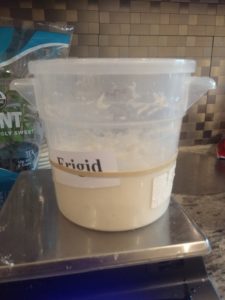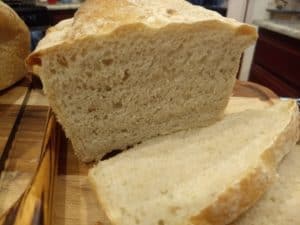
2020-03-04 Feeding the neglected starter
Part 2, Frigid and Scruffy Meet The Big Bang Theory
Hello Bread Heads!
In the previous issue of the Mike's (more or less) Weekly Baking Tips I talked at some length about feeding two neglected starters. One starter, which I called "Scruffy", had been at room temperature without feeding for about 6 weeks. It was quite stinky. The other was my usual starter which had been in the refrigerator and unfed for around 3 months. I called that one "Frigid".
It is worth noting that they are both the same starter. Scruffy was made from Frigid and fed up to about 2 liters to get ready for a bake. Then I had some medical issues and my wife and I totally ignored the 2 liters of starter for about 6 weeks. There is more detail about this in the previous Mike's (more or less) Weekly Baking Tips.
It surprised me that the two starters revived in the same amount of time and produced breads I could not tell apart. A few people told me that I was too fussy and persnickety with my starters and that they just fed their starters once before they wanted to use them and the starters roared back to life.
This really contradicted everything I'd heard and read about starter maintenance - all the books have you carefully baby the starter - so I had to try it out. Luckily, there was some Scruffy and Frigid left over for another experiment. That said, let's get going. Again, I wanted to make 500 grams of each starter, and then I'd bake some bread with the starters. The feeding schedule was very simple - to 10 grams of the neglected starter I added 245 grams of water and then stirred it to evenly distribute the starter. Next, I added 245 grams of flour and stirred that as well. No additional feedings were planned, as this was a once and done big-bang sort of thing.
Frigid
Scruffy
The neglected starters before the first feeding, Saturday evening about 7:00 PM
The starters immediately after their first feeding
12 Hours after their first feeding, Sunday morning about 7::00 AM, things haven't really changed very much. I can imagine that Frigid has grown a little. Scruffy not so much.
12 more hours, Sunday evening about 7:00 PM. Frigid has taken off, Scruffy is barely active.
12 hours later, Monday morning around 7:00 AM, Frigid has fallen, Scruffy has risen to the occasion.
A side by side view of the starters on Monday morning, about 7:00 AM
With the starter active, it's time to make some bread. We went back to an old favorite recipe, the Simple Sourdough Pan Bread from The Friends of Carl. It's a great recipe that delivers a nice soft sandwich pan bread. It has a nice crust and a very nice tang to it. Of course, the bread can change depending on your starter and the flour you are using. One of things that makes the recipe special is how the author describes how the dough should look and feel at each stage. Too many recipe authors elide those details expecting that if you add the ingredients correctly it will come out right. Sadly, there is more to baking than ingredients.
In any case, I made a two loaf batch of bread with each of the starters. It was interesting that the Scruffy loaf took more flour to reach the correct consistency, yet the dough was still softer than the Frigid loaf.
The loaves were slashed when they were formed. They proofed nicely, but when I moved the Scruffy loaves, they collapsed slightly. The Scruffy loaves had also not risen quite as far as the Frigid loaves.
Let's look at the loaves.... Scruffy collapsed and slumped a bit
A look at the sliced loaves
This is a closer crumb comparison. I cut a slice of each bread, cut the slices in half and then photographed them together.
The overall structure of the loaf made with the Frigid starter was better. That loaf also had more of a sour taste. The Scruffy loaf's crumb was somewhat gummy.
While it isn't obvious due to the lighting, the Scruffy loaf's crumb was slightly darker than the Frigid loaf's crumb. Both were decent, but Frigid was better.
Conclusions....
Well, the smoke has cleared, and now it's time to figure out what it all means. To start with, I was amazed that the big-bang theory feeding worked so well, and that the breads turned out so well. It leaves me feeling that I have another fall-back in case I forget to make a starter for a class.
Should I be concerned that the two starters didn't work at the same speed? It took Scruffy 12 hours longer to reach a peak than Frigid. Would the two starters work at the same speed next time as this? I suspect they would, and that it isn't a fundamental consistency problem. I'll have to try it again and see what happens.
Why were the two breads not quite the same color? Why did they taste not quite the same? Would they have been closer together if I had let the Scruffy starter age 12 more hours? Since the Simple Sourdough Pan Bread recipe starts by fermenting the starter for 8 to 10 more hours, it isn't clear that letting Scruffy age for 12 more hours would have taken care of the inconsistencies.
For me, consistency is a very big issue. Not as big an issue as not working, but a very big issue. I suspect my usual approach of feeding a starter every 12 hours over a 3 day period may result in a more consistent starter, as would the Detmolder 3-Stage process. If you are baking for yourself and your family, this may not be a real issue. If you are baking commercially, it could be a matter of bakery life and death.
Does it sound like I haven't really reached a conclusion? There's a reason for that. I'll be back with a followup report, without so many pictures, fairly soon.
Pizza? Did someone say pizza?
And now, for something completely different. Long time readers know I am a big fan of the free Pizza Today magazine and web site. It is full of great pizza ideas and recipes. In the most recent issue I saw, they had a great pizza dough recipe. It shouldn't be a surprise it's a great recipe since Leah Scurto is a champion pizza maker. It's a yeast based recipe and it takes 4 days to be ready, but it IS worth it. The dough also freezes well. Of course, I'm a sourdough nut, so I am working on converting it to sourdough. The first test batch is in a 2 day ferment now, and I should be making pizza with it tomorrow night. Then we'll see if we need to correct the recipe. If we get a good recipe, I'll let you know, of course.
Until next time, may your dough always rise consistently, no matter what weird stuff you did to your starter this time,
-Mike























